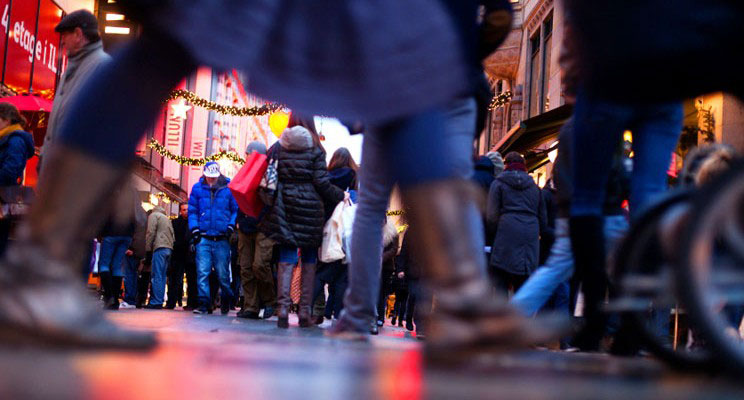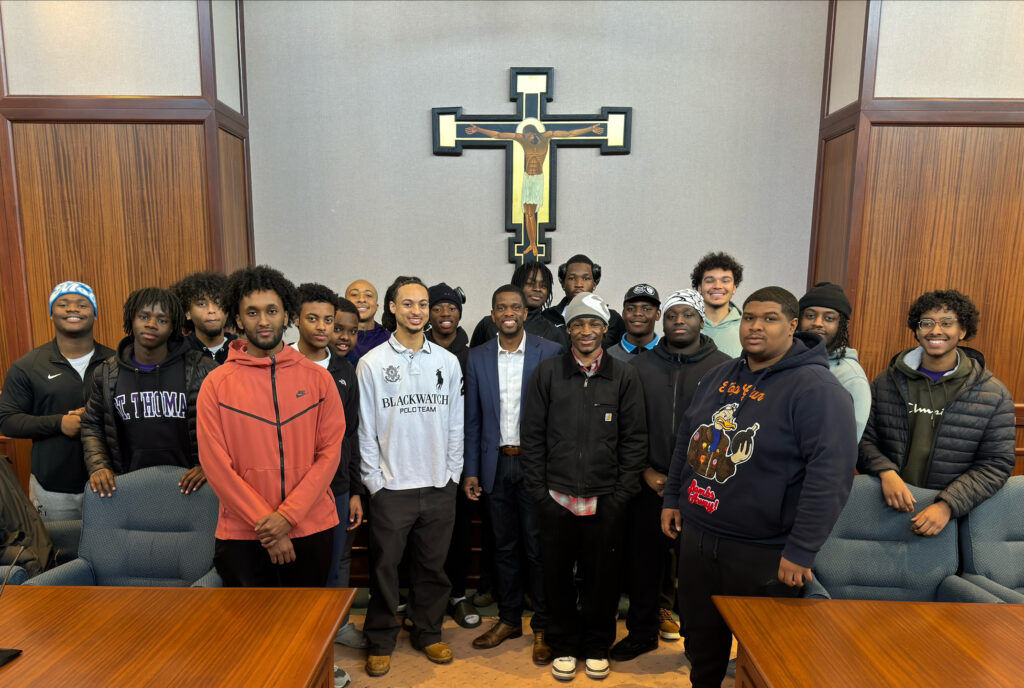The spirit of holiday giving is alive and well in the Twin Cities, according to research conducted by marketing professors at the University of St. Thomas.
Metro-region shoppers are planning to spend $918 per household this holiday season. That’s the highest amount since the St. Thomas Holiday Sentiment Survey began 15 years ago; it’s up $68 or 8 percent over last year.
The annual survey is conducted in late October and early November and provides data on Twin Cities holiday shopping trends. The survey measures the intent of Twin Cities shoppers: how much they think they will spend for holiday gifts, what they will spend it on and where they will spend it.
The research is conducted by Dr. Lorman Lundsten, Dr. Sandra Rathod and Jonathan Seltzer at St. Thomas’ Opus College of Business.
When shoppers were asked in general terms if they’d spend more or less, their answers were slightly less optimistic than a year ago. This year 15 percent said they would spend more while last year it was 18 percent. This year 25 percent said they would spend less while last year it was 22 percent. And this year 61 percent said they’d spend about the same, which is close to last year’s 59 percent.
It might seem unusual to see that this year’s household dollar amount is up 8 percent while the spending-intent comments are slightly less optimistic. The professors note that the slight changes in the spending-intent comments fall within the survey’s margin of error.
“There were no big surprises in our findings,” Rathod said. “It is clear that Twin Cities shoppers are optimistic and their responses generally reflect national surveys and projections for 2016.”
Deloitte & Touche is predicting a 3.6 to 4 percent increase in holiday spending, the National Retail Federation is predicting 3.6 percent, the International Council of Shopping Centers is predicting 3.3 percent and PwC U.S. is predicting 10 percent.
“After hitting something of a plateau last year, I think the Twin Cities’ numbers for 2016 are pointing north to a more optimistic outlook,” Lundsten said.
Based on survey responses from greater Minneapolis-St. Paul metro-area residents, the St. Thomas professors predict that metro-region holiday shoppers will cumulatively spend $1.24 billion this year, up 9 percent from last year’s $1.14 billion. The prediction is based on the per-household spending increase combined with an increase in the metro-area population of about 1 percent.
Survey respondents said they will have completed 25 percent of their shopping by Nov. 1 and predicted they would have 59 percent of their shopping wrapped up by Dec. 1. That is more than last year, when respondents said they were 19 percent done by Nov. 1 and 52 percent by Dec. 1.
“While there is no snow to put us in a holiday mood, our unusually warm fall might be making it easier for shoppers to get to the stores and malls,” Seltzer said.
The St. Thomas professors who conducted the study emphasize that actual spending might be different because shoppers could spend more or less than they planned once they get into the stores or online.
A peek under the tree
What will Twin Cities shoppers buy with their $918? The professors created an index to analyze the relative popularity of 14 gift categories. It sheds light on the “what’s hot” question and allows year-to-year comparisons.
Gift certificates remained the top pick again this year, although there were some changes in the order of popularity. A category called travel and events, which includes plays and shows, moved from sixth place last year to second place this year. Two other categories with notable changes are jewelry, which moved down from ninth place last year to 13th this year, and computer-related gifts, which moved up from 13th last year to eighth this year.
Three somewhat related categories – cellphones, consumer electronics and video games – all are near the bottom of the list.
Here’s how this year’s survey respondents ranked their gift choices, listed with most popular at the top:
- Gift certificates (last year 1)
- Travel and events (including plays and shows) (last year 6)
- Cash (last year 2)
- Clothing/accessories (last year 4)
- Books (last year 3)
- Entertainment products (recorded music and movies) (last year 5)
- Toys and hobbies (last year 7)
- Computer related (last year 13)
- Sporting goods (last year 8)
- Cell or mobile phones (last year 10)
- Consumer electronics (last year 12)
- Furniture/furnishings (last year 11)
- Jewelry (last year 9)
- Video game related (last year 14)
Where they spend
For the past 15 years the survey asked shoppers where they plan to spend their money. In 2002, respondents said they would spend:
- 51 percent of their budget at shopping malls or downtowns
- 32 percent at non-mall stores
- 7 percent via the internet
- 9 percent in a category that combines catalogs, television ads and phone sales
In 2016, respondents said they would spend:
- 40 percent of their budget at shopping malls or downtowns
- 17 percent at non-mall stores
- 39 percent via the internet
- 5 percent in a category that combines catalogs, television ads and phone sales
“Over the past 15 years, internet shopping increased steadily at the expense of the other categories,” Lundsten said. “But this year we saw a leveling off or plateau. Last year and this year, both the malls and the internet received between 38.5 percent and 39.6 percent of the shopping dollar.”
To find out what kind of internet sites are most popular with shoppers, researchers asked respondents to indicate what portion of their internet spending would be done on four kinds of online sites:
- “Internet only” sites, such as Amazon, received 43 percent (same as last year).
- “Bricks and clicks” sites, operated by stores such as Target, received 35 percent (last year 40 percent).
- “Broker-facilitator” sites, such as eBay, received 4 percent (same as last year).
- “Deals” sites, such as Groupon, received 5 percent (last year 3 percent).
Again this year, respondents were asked to list two stores and two websites where they planned to shop.
In the store category the five most popular, in order, were Target, Macy's, Kohls, Herberger's and Best Buy.
In the website category the five most popular were Amazon, Target, eBay, Macy's and Best Buy.
Amazon was by far the most popular website; it was mentioned 11 times more often than second-place Target.
Most-popular malls and shopping areas
Which of the region’s 16 enclosed malls, outdoor shopping centers and downtowns are going to attract the most shoppers?
The researchers approached that question from two perspectives: first, which mall in the region are consumers planning to visit at least once for holiday shopping; second, which mall are they planning to shop at most for the holidays. The results are not the same.
When asked which malls or downtowns they planned to visit at least once for their holiday shopping, survey respondents listed, from most-popular to least-popular (note: Use caution when comparing this year’s numerical rank to last year’s numerical rank because last year there were some ties and this year there are none):
- Mall of America (last year 1)
- Rosedale (last year 2)
- Southdale (last year 3)
- Ridgedale (last year 5)
- Galleria (last year 8)
- Burnsville (last year 3)
- Maplewood (last year 7)
- Albertville Outlet Center (last year 10)
- Arbor Lakes Area (last year 7)
- Downtown Minneapolis (last year 9)
- Woodbury Lakes Area (last year 8)
- Eden Prairie (last year 4)
- Riverdale Area (last year 7)
- Northtown (last year 11)
- Premium Outlets of Eagan (last year 6)
- Downtown St. Paul (last year 12)
The Mall of America, Rosedale and Southdale have held these one-two-three rankings for the past seven years, as well as 13 years ago when the survey began. The Mall of America has been the top, shop-at-least-once-for-the-holidays mall for all 15 years with the exception of 2004-06 when Rosedale was No. 1.
When asked where they planned to do most of their holiday shopping this year, respondents listed, in order (note: Again use caution when comparing this year’s numerical rank to last year’s numerical rank because last year there were some ties and this year there are none):
- Mall of America (last year 2)
- Ridgedale (last year 5)
- Burnsville (last year 6)
- Maplewood (last year 6)
- Rosedale (last year 1)
- Southdale (last year 4)
- Woodbury Lakes area (last year 7)
- Eden Prairie (last year 3)
- Riverdale Area (last year 9)
- Premium Outlets of Eagan (last year 10)
- Northtown (last year 11)
- Arbor Lakes Area (last year 8)
- Downtown Minneapolis (last year 11)
- Albertville Outlet Center (last year 12)
- Downtown St. Paul (last year 14)
- Galleria (last year 13)
“It has been interesting to watch the evolution of our shopping malls,” Lundsten said. “We started with the big 'dale' malls, like Rosedale and Southdale. Then we started seeing some new locations, like Woodbury Lakes and Ridgedale, stepping up and competing with the big, original shopping sites.”
2016 bonus questions
In addition to the same survey questions the St. Thomas professors ask each year, they added some new ones for 2016: one about the Macy’s department store in downtown Minneapolis, and another about how much shoppers plan to spend after Christmas.
Noting in the survey that Macy’s is closing some of its stores, the survey asked if closing the downtown Minneapolis Macy’s would affect a shopper’s behavior. Eighty-three percent said they didn’t expect it would change their shopping habits if the large downtown store was closed. Eight percent said they’d probably do the same amount of shopping at Macy’s, but at a suburban location.
And on the question related to post-holiday shopping, respondents said that of every $100 they planned to spend on holiday gifts before Christmas, they would spend an additional $15 after Christmas. Based on the predicted household spend of $918, that would mean an additional 15 percent, or $135, would be spent after Dec. 25.
“There are changes in holiday-shopping patterns,” Seltzer said. “It does not end on Christmas Day. In addition to the gifts that are returned for refunds or exchanged for something else, there are all the very popular cards people receive and the post-holiday sales where retailers are clearing shelves to get ready for spring merchandise.”
The researchers
Lundsten, Rathod and Seltzer are members of the Opus College of Business faculty.
Lundsten is a professor emeritus of marketing who taught marketing research and strategy. He holds a doctorate from the University of Michigan.
Rathod is the Opus College of Business Distinguished Service Professor of Marketing. She teaches marketing strategy, consumer behavior, market research and applied business research. She holds a Ph.D. in consumer behavior from Purdue University.
Seltzer teaches international marketing and distribution channels. A former vice president of industry and government relations at Supervalu Inc., he holds an MBA from the University of Chicago.
The Institute for Retailing Excellence, part of the Opus College of Business, conducts research and offers educational programs for those who work in retailing.
Survey method
This year’s holiday spending survey included 304 online responses from households in the 13-county Minneapolis-St. Paul Metropolitan Statistical Area, which includes two counties in western Wisconsin. The respondents reflect the demographics of the area as well as those who responded to previous holiday spending surveys.







